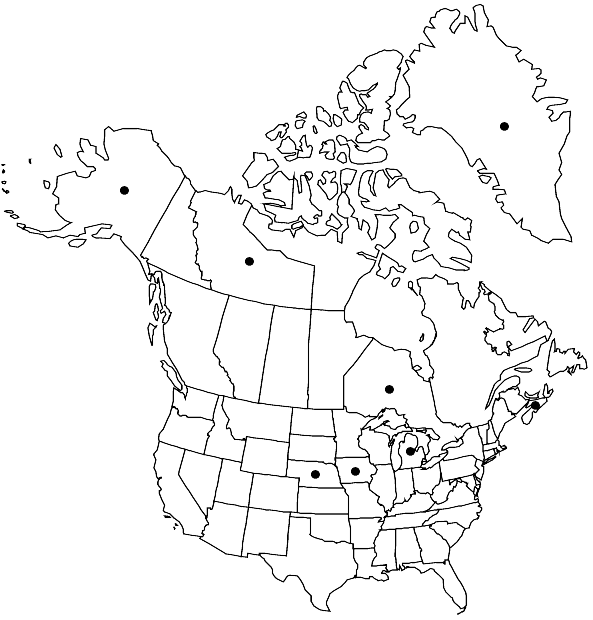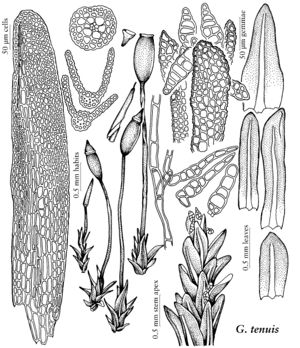Gyroweisia tenuis
Syn. Musc. Eur. ed. 2, 38. 1876,.
Plants scattered or very loosely cespitose. Stem to 0.4 cm, central strand absent. Leaves 0.25–1(–1.4) mm, erect to incurved when dry, spreading when moist, base broadened in lower 1/3–1/2, long-rectangular; margins entire; costa ending 2–4 cells below the apex, cells of adaxial surface elongate and flat (not bulging), costa in section with 1 or 2 stereid bands or costa homogeneous; distal laminal cells quadrate, with 3–4 irregular to 2-fid papillae, walls thin and evenly thickened, lumens angular; basal cells differentiated across leaf, filling the leaf base; medial cells hyaline to yellowish, smooth or weakly papillose above, 10–12 µm wide, 2–4:1, walls thin. Specialized asexual reproduction commonly present in sterile material as gemmae in the axils of leaves, elongate, irregularly clavate, short-branching, or spindle-shaped, of mostly 4–10 cells. Sexual condition dioicous; perichaetial leaves strongly differentiated and sheathing the seta. Capsule lacking peristome, annulus revoluble, operculum short-conic.
Habitat: Thin soil and in rock crevices, sandstone, calcareous rock
Elevation: low to moderate elevations (70-1000 m)
Distribution

Greenland, N.W.T., N.S., Ont., Alaska, Iowa, Mich., Nebr., Europe, Asia (China, Middle East), n Africa.
Discussion
Gyroweisia tenuis is similar to and often confused with Gymnostomum aeruginosum but the latter has elongate leaves that are commonly acute (occasionally apiculate by a single cell), with quadrate to rectangular (but bulging) cells on the adaxial surface of the costa, gemmae are absent, the perichaetial leaves are little differentiated from the cauline or sheathing the seta only in lower 1/3 of leaf, the annulus is vesiculose but persistent, and the operculum is long-conic. Specimens from the upper Great Lakes region are generally fruiting and have very short stems. A comparatively long-stemmed specimen lacking sporophytes from Nebraska (Brown County, Churchill 12286, BC, DUKE, MO) has the characteristic narrowly rectangular cauline leaves and immature but strongly differentiated perichaetial leaves of Gyroweisia tenuis, and several-celled ovoid or spindle-shaped gemmae arising from axils of terminal leaves of sterile axes. It is distinguished from Gymnostomum calcareum by the present of gemmae, and from Gymnostomum viridulum by the narrowly rectangular leaves.
Selected References
None.
